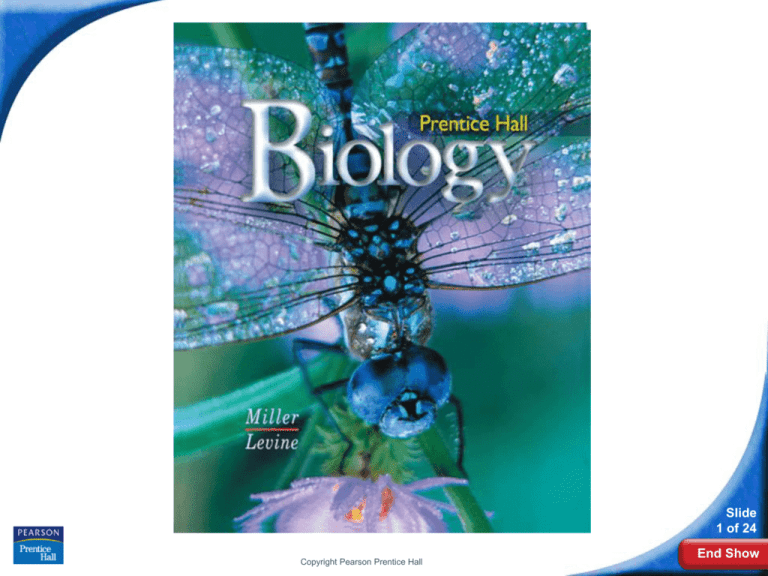
Biology
Slide
1 of 24
Copyright Pearson Prentice Hall
End Show
24-2 Seed Development
and Germination
Slide
2 of 24
Copyright Pearson Prentice Hall
End Show
24-2 Seed Development and
Germination
Seed and Fruit Development
How do fruits form?
Slide
3 of 24
Copyright Pearson Prentice Hall
End Show
24-2 Seed Development and
Germination
Seed and Fruit Development
Seed and Fruit Development
As angiosperm seeds mature, the ovary
walls thicken to form a fruit that encloses
the developing seeds.
Slide
4 of 24
Copyright Pearson Prentice Hall
End Show
24-2 Seed Development and
Germination
Seed and Fruit Development
A fruit is a ripened ovary that contains angiosperm
seeds.
As seeds mature, the ovary walls thicken to form a
fruit that encloses the developing seeds.
Slide
5 of 24
Copyright Pearson Prentice Hall
End Show
24-2 Seed Development and
Germination
Seed Dispersal
How are seeds dispersed?
Slide
6 of 24
Copyright Pearson Prentice Hall
End Show
24-2 Seed Development and
Germination
Seed Dispersal
Seed Dispersal
Seeds are dispersed by animals, wind, and
water.
Seeds dispersed by animals are typically
contained in fleshy, nutritious fruits.
Slide
7 of 24
Copyright Pearson Prentice Hall
End Show
24-2 Seed Development and
Germination
Seed Dispersal
Seeds of many plants are eaten by animals.
These seeds are covered with tough coatings that
protect them from digestive chemicals, allowing them
to pass through an animal’s digestive system
unharmed.
The seeds then sprout in the feces eliminated from
the animal.
Slide
8 of 24
Copyright Pearson Prentice Hall
End Show
24-2 Seed Development and
Germination
Seed Dispersal
Seeds dispersed by wind or water are
typically lightweight, allowing them to
be carried in the air or to float on the
surface of the water.
Slide
9 of 24
Copyright Pearson Prentice Hall
End Show
24-2 Seed Development and
Germination
Seed Dispersal
Some seeds are encased in winglike structures that
spin and twirl, helping them glide from their parent
plants.
A coconut is buoyant enough to float in seawater
within its protective coating for many weeks.
Tumbleweed plants break off at their roots and
scatter their seeds as they are blown by the wind.
Slide
10 of 24
Copyright Pearson Prentice Hall
End Show
24-2 Seed Development and
Germination
Seed Dormancy
Seed Dormancy
Many seeds will not grow when they first mature.
These seeds enter a period of dormancy, during
which the embryo is alive but not growing.
The length of dormancy varies in different plant
species.
Slide
11 of 24
Copyright Pearson Prentice Hall
End Show
24-2 Seed Development and
Germination
Seed Dormancy
What factors influence the dormancy and
germination of seeds?
Slide
12 of 24
Copyright Pearson Prentice Hall
End Show
24-2 Seed Development and
Germination
Seed Dormancy
Environmental factors such as
temperature and moisture can cause a
seed to end dormancy and germinate.
Seed dormancy can be adaptive in several
ways:
• allows for long-distance dispersal
• allows seeds to germinate under ideal
growth conditions
Copyright Pearson Prentice Hall
Slide
13 of 24
End Show
24-2 Seed Development and
Germination
Seed Germination
Seed Germination
Seed germination is the early growth stage of the
plant embryo.
When seeds germinate, they absorb water which
causes food-storing tissues to swell and crack
open the seed coat.
The young root grows through the cracked seed
coat.
Slide
14 of 24
Copyright Pearson Prentice Hall
End Show
24-2 Seed Development and
Germination
Seed Germination
In most monocots, the single cotyledon remains
underground.
The growing shoot emerges while protected by a
sheath.
Slide
15 of 24
Copyright Pearson Prentice Hall
End Show
24-2 Seed Development and
Germination
Seed Germination
Foliage
leaves
Young
shoot
Germinating
seed
Primary
root
Corn (monocot)
Copyright Pearson Prentice Hall
Slide
16 of 24
End Show
24-2 Seed Development and
Germination
Seed Germination
In dicots, germination takes place in one of two ways.
•
In some species, the cotyledons emerge above
ground, protecting the stem and first foliage
leaves.
•
In other species, the cotyledons stay
underground and provide a food source for the
growing seedling.
Slide
17 of 24
Copyright Pearson Prentice Hall
End Show
24-2 Seed Development and
Germination
Young
shoot
Seed Germination
Foliage
leaves
Cotyledons
Cotyledons
Seed coat
Germinating
seed
Primary
root
Bean (dicot)
Slide
18 of 24
Copyright Pearson Prentice Hall
End Show
24-2
Click to Launch:
Continue to:
- or -
Slide
19 of 24
End Show
Copyright Pearson Prentice Hall
24-2
A germinating corn seedling has
a. a single cotyledon, which remains below
ground.
b. two cotyledons, which push above ground.
c. a single cotyledon, which pushes above
ground.
d. two cotyledons, which remain below
ground.
Slide
20 of 24
End Show
Copyright Pearson Prentice Hall
24-2
Angiosperm fruits develop from
a. the ovary wall of the flower.
b. seed endosperm.
c. swollen sepals of the flower.
d. flower stamens.
Slide
21 of 24
End Show
Copyright Pearson Prentice Hall
24-2
An example of a seed that is transported by
water is a
a. coconut.
b. tumbleweed.
c. blackberry.
d. maple seed.
Slide
22 of 24
End Show
Copyright Pearson Prentice Hall
24-2
The seeds of many plants that form fruits are
dispersed mainly by
a. animals.
b. water.
c. wind.
d. the plant itself.
Slide
23 of 24
End Show
Copyright Pearson Prentice Hall
24-2
An environmental condition that can cause the
activation of a dormant seed is
a. a sharp drop in temperature.
b. the heat from a forest fire.
c. an extended drought.
d. falling from a great height.
Slide
24 of 24
End Show
Copyright Pearson Prentice Hall
END OF SECTION





